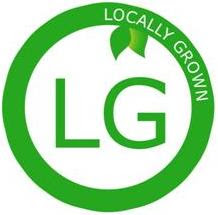The Locally Grown (& Eaten) Challenge: Aug ’14
 This just might be the most sumptuous challenge yet. We do not get too many months a year of locally grown food so we might as well turn it into a challenge. Take time each day or each week to eat locally grown produce: Fruits, vegetables, herbs – there is lots of it out there these days! Naturally we’d like to hear (in the comment section below) what you are eating, where you got it, and how good it was. I know some of you have great gardens (send pics) and others might have a favorite farmer / farmer’s market. Or you might have a generous neighbor who shares their bounty. I know I need to make a shout out to Angie, Annie, & Katy for wonderful cucumbers, zucchini, and tomatoes! Whatever your pathway, aim to make August your month to focus on eating locally grown fare.
This just might be the most sumptuous challenge yet. We do not get too many months a year of locally grown food so we might as well turn it into a challenge. Take time each day or each week to eat locally grown produce: Fruits, vegetables, herbs – there is lots of it out there these days! Naturally we’d like to hear (in the comment section below) what you are eating, where you got it, and how good it was. I know some of you have great gardens (send pics) and others might have a favorite farmer / farmer’s market. Or you might have a generous neighbor who shares their bounty. I know I need to make a shout out to Angie, Annie, & Katy for wonderful cucumbers, zucchini, and tomatoes! Whatever your pathway, aim to make August your month to focus on eating locally grown fare.
Also for all your farmers out there who have overstock of one thing and not enough of another, share below what you have to trade and we can all get to bartering goods. We did this in the past and it was worked out well.
Looking forward to the month ahead!!
7 Benefits of Eating Locally
(Courtesy of Michigan State University)
- Locally grown food is full of flavor. When grown locally, the crops are picked at their peak of ripeness versus being harvested early in order to be shipped and distributed to your local retail store. Many times produce at local markets has been picked within 24 hours of your purchase.
- Eating local food is eating seasonally. Even though we wish strawberries were grown year round, the best time to eat them is when they can be purchased directly from a local grower. They are full of flavor and taste better than the ones available in the winter that have traveled thousands of miles and picked before they were ripe.
- Local food has more nutrients. Local food has a shorter time between harvest and your table, and it is less likely that the nutrient value has decreased. Food imported from far-away states and countries is often older, has traveled and sits in distribution centers before it gets to your store.
- Local food supports the local economy. The money that is spent with local farmers and growers all stays close to home and is reinvested with businesses and services in your community.
- Local food benefits the environment. By purchasing locally grown foods you help maintain farmland and green and/or open space in your community.
- Local foods promote a safer food supply. The more steps there are between you and your food’s source the more chances there are for contamination. Food grown in distant locations has the potential for food safety issues at harvesting, washing, shipping and distribution.
- Local growers can tell you how the food was grown. You can ask what practices they use to raise and harvest the crops. When you know where your food comes from and who grew it, you know a lot more about that food.

This is one challenge the Johnsons will rise to! Really love this….tomorrow will be my first deliberate foray for this purpose!
Okay, Satyam, I am home with locally grown cantaloupes from the Eastern which I will share in a smoothie tomorrow!
That sounds absolutely wonderful…
Have tried a few very good local tomatoes from local farms selling on the roadside. Next to High’s Market on Rt 260 in Owings on the way to Ches Beach and from Paddy’s Farm Stand on Rt 258 approx halfway between Rt 2 & Rt 4.
That smoothie was nothing short of awesome!!!
This is my first year buying a CSA from Calvert County’s Chestnut Land Trust. We have had a bounty of veggies we share with our family. My freezer is stocked with zucchini bread and greens ready for winter feasting! A great experience, I love my Wednesday drive down the wooded Double Oak Road to the barn where baskets of green, yellow and red goodness awaits.
Indeed, there are a lot of CSA’s around here and that can be a very good way to go. One out of the Edgewater area is the IVY brand CSA:
http://www.ivybrand.com/commerce.html
Eating locally grown food is just as same as cooking at home vs eating fast food. You know what you put in your food and how it is made. It is a more healthy choice. My aunt is such a big fan of good old home cooking. Great tips.